
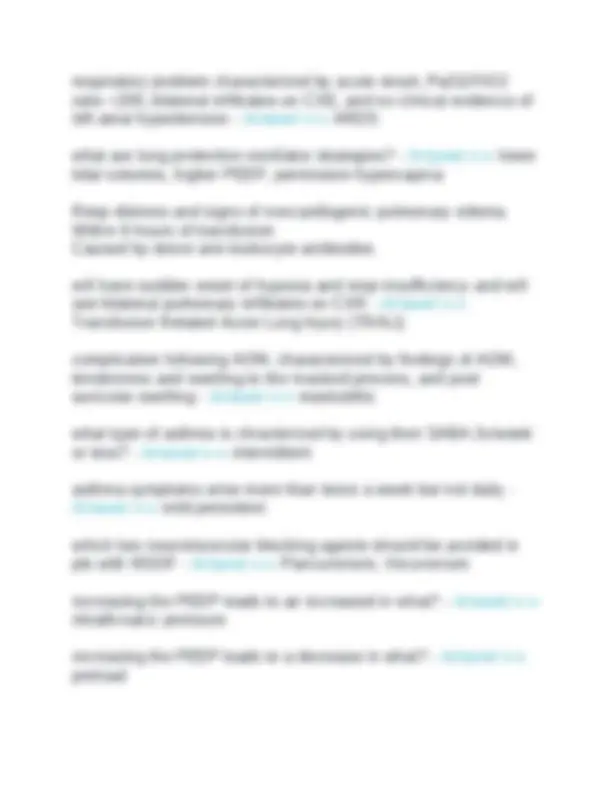
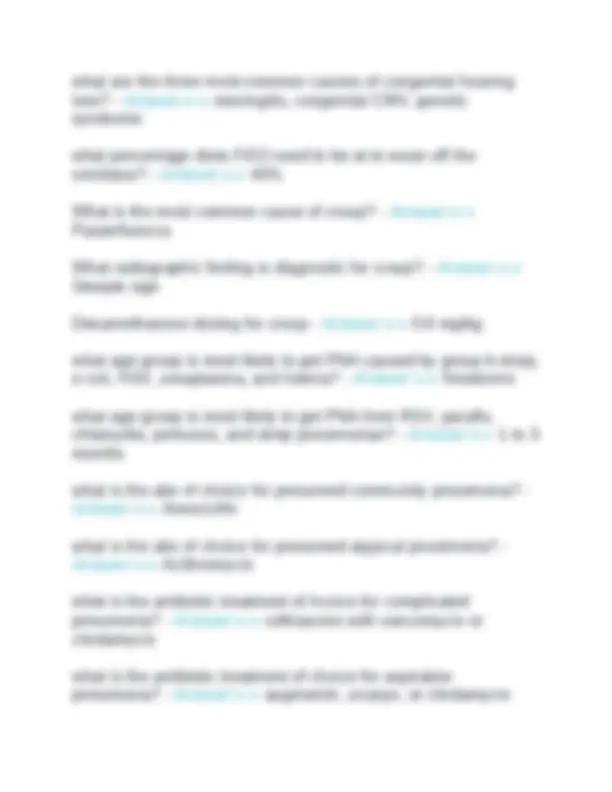
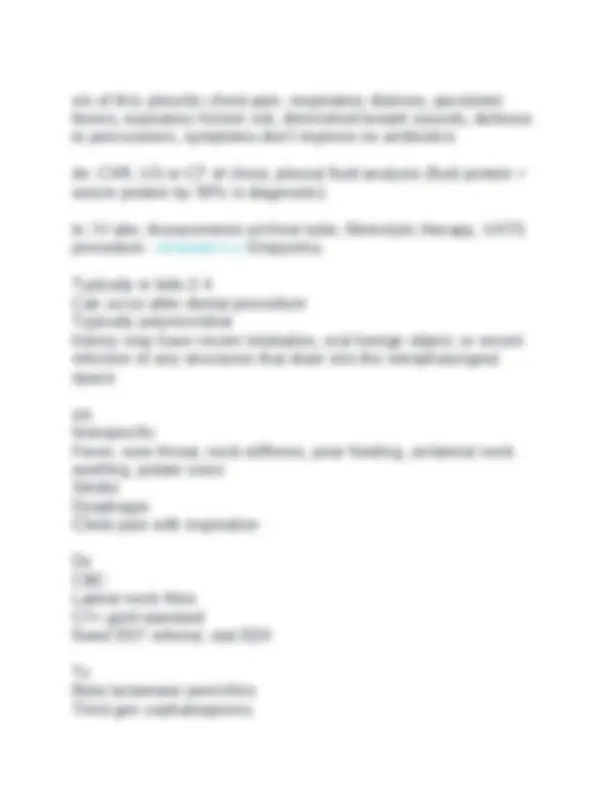
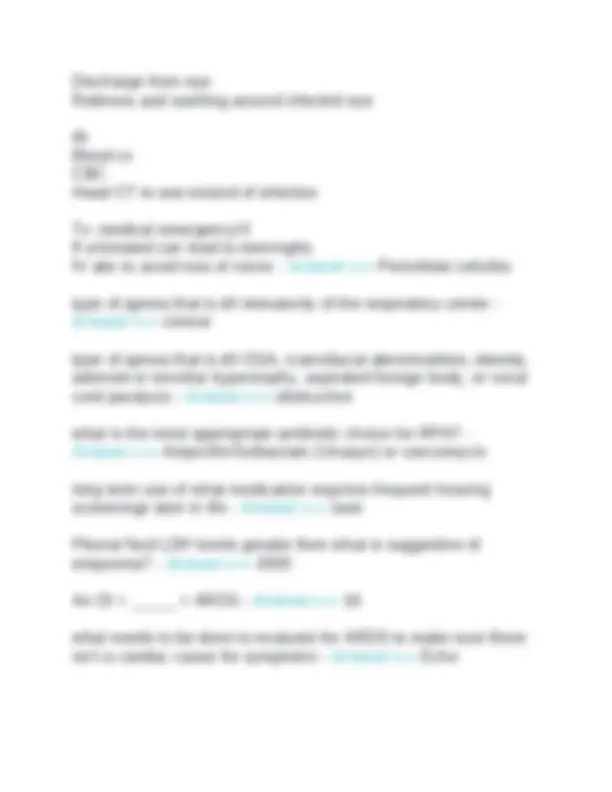
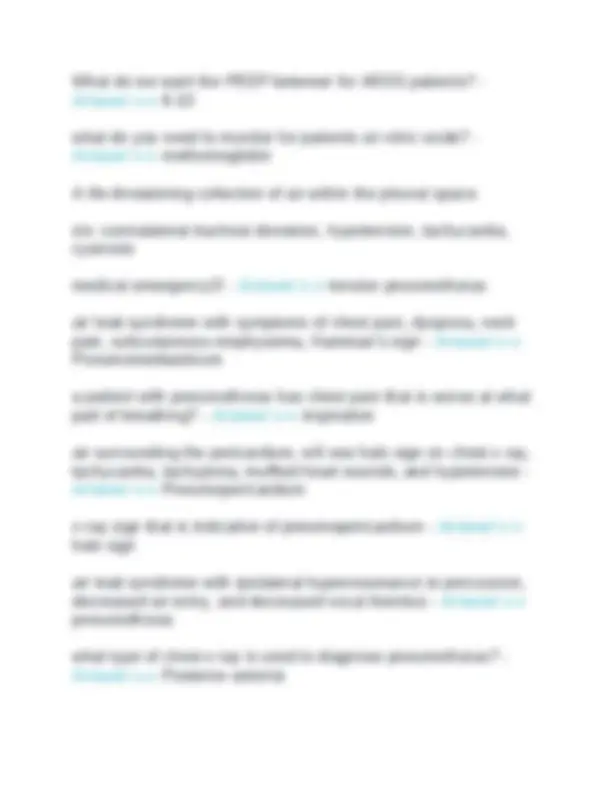
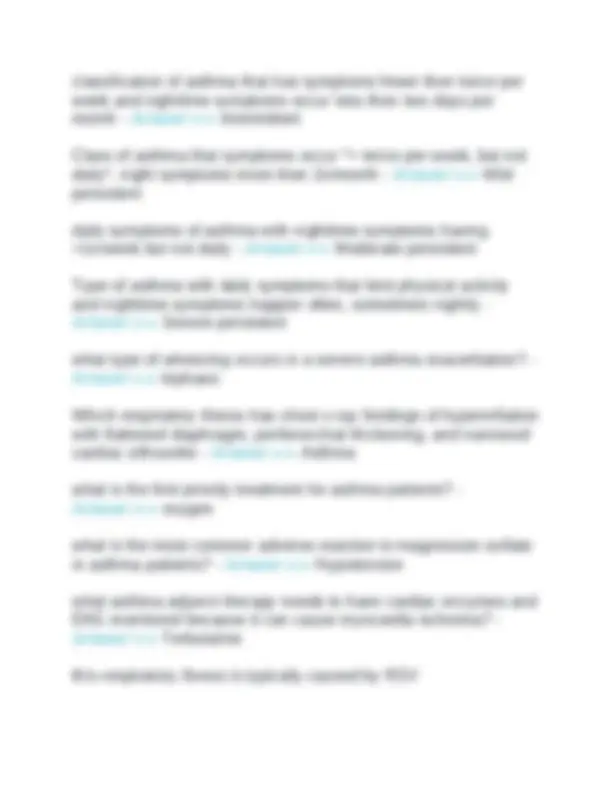



Study with the several resources on Docsity

Earn points by helping other students or get them with a premium plan


Prepare for your exams
Study with the several resources on Docsity

Earn points to download
Earn points by helping other students or get them with a premium plan
Community
Ask the community for help and clear up your study doubts
Discover the best universities in your country according to Docsity users
Free resources
Download our free guides on studying techniques, anxiety management strategies, and thesis advice from Docsity tutors
A comprehensive review guide for the pnp-ac (pediatric nurse practitioner - acute care) 2024 exam, focusing on respiratory and eent (eye, ear, nose, and throat) topics. It covers a wide range of subjects, including airway management, respiratory disorders, ventilation strategies, and various pediatric respiratory and eent conditions. Detailed questions and answers, allowing students to test their knowledge and prepare for the upcoming exam. The content is structured in a clear and organized manner, making it a valuable resource for pnp-ac students and professionals seeking to enhance their understanding of these critical areas in pediatric acute care nursing.
Typology: Exams
1 / 13

This page cannot be seen from the preview
Don't miss anything!








Mallampati scoring of difficult airway - Answer>> Class 3 or > People with these genetic conditions are _______ risk for intubating: Pierre Robin (small jaw), Treacher collin, turners, downs, Beckwith-Weiderman (large tongue) - Answer>> High What type of ETT has this formula for sizing: (age in years/4) + 4 - Answer>> Uncuffed What type of ETT has this formula for sizing: (age in years/4) + 3 - Answer>> Cuffed phase of pertussis URI symptoms lasting 1-2 weeks. Most contagious during this phase, infants may only present with apnea. older kids present with fever, fatigue, rhinorrhea, conjunctivitis - Answer>> Catarrhal Phase of pertussis with staccato cough and resolution of fever, makes the whooping couch sound. Non-toxic appearing - Answer>> Paroxysmal Phase of pertussis in which the residual cough persists for weeks to months and is usually triggered by exposure to another upper respiratory infection or irritant. - Answer>> Convalescent Treatment for pertussis - Answer>> Erythromycin (1st line), Azithro, Clarithro
complications of hyphema - Answer>> vision loss and glaucoma appropriate tidal volumes in infants - Answer>> 6-7 mL/kg type of ventilation that indicates that the patient can initiate breaths spontaneously and is determining the volume of theses breaths on their own - Answer>> pressure support what complication is the result of distal alveolar rupture and is associated with high ventilator pressures and severe lung disease
what are the three most common causes of congenital hearing loss? - Answer>> meningitis, congenital CMV, genetic syndrome what percentage does FiO2 need to be at to wean off the ventilator? - Answer>> 40% What is the most common cause of croup? - Answer>> Parainfluenza What radiographic finding is diagnostic for croup? - Answer>> Steeple sign Dexamethasone dosing for croup - Answer>> 0.6 mg/kg what age group is most likely to get PNA caused by group b strep, e coli, HSV, ureaplasma, and listeria? - Answer>> Newborns what age group is most likely to get PNA from RSV, paraflu, chlamydia, pertussis, and strep pneumoniae? - Answer>> 1 to 3 months what is the abx of choice for presumed community pneumonia? - Answer>> Amoxicillin what is the abx of choice for presumed atypical pnuemonia? - Answer>> Azithromycin what is the antibiotic treatment of hcoice for complicated pneumonia? - Answer>> ceftriaxone with vancomycin or clindamycin what is the antibiotic treatment of choice for aspiration pneumonia? - Answer>> augmentin, unasyn, or clindamycin
s/s of this: pleuritic chest pain, respiratory distress, persistent fevers, expiratory friction rub, diminished breath sounds, dullness to percussions, symptoms don't improve on antibiotics dx: CXR, US or CT of chest, pleural fluid analysis (fluid protein > serum protein by 50% is diagnostic) tx: IV abx, thoracentesis w/chest tube, fibrinolytic therapy, VATS procedure - Answer>> Empyema Typically in kids 2- Can occur after dental procedure Typically polymicrobial history may have recent intubation, oral foreign object, or recent infection of any structures that drain into the retropharyngeal space s/s Nonspecific Fever, sore throat, neck stiffness, poor feeding, unilateral neck swelling, potato voice Stridor Dysphagia Chest pain with inspiration Dx CBC Lateral neck films CT= gold standard Need ENT referral, stat ED!! Tx Beta lactamase penicillins Third gen cephalosporins
tx: 3rd gen cephalosporin, steroids for inflammation, vanc if concerned for staph aureus. tx for 7-10 days - Answer>> Epiglottitis inflammation of the trachea commonly caused by staph aureus or community MRSA s/s: high fever with toxic appearance, leukocytosis, stridor, barky cough, several day croup like history dx: lateral neck x-ray tx: intubation, empiric antibiotic therapy - Answer>> tracheitis abscess that forms behind the tonsil, a local cellulitis s/s: recent hx of strep throat, fever, lymphadenopathy, uvula deviation, drooling, muffled speech, neck swelling, ear pain on affected side, tripod positioning dx: throat culture, neck I&D, CT with contrast tx: I&D, unasyn, clindamycin MEDICAL EMERGENCY - Answer>> Peritonsillar abscess Patho: inflammation of the eyelid and surrounding tisues Common in kids <5 yo Pathogens: Haemophilus influenza, s. pneumonie Often d/t trauma, insect bites, severe sinusitis, conjunctivitis, or dental abscess S/s +/- fever lymphadenopathy
Discharge from eye Redness and swelling around infected eye dx Blood cx CBC Head CT to see extend of infection Tx: medical emergency!!! If untreated can lead to meningitis IV abx to avoid loss of vision - Answer>> Periorbital cellulitis type of apnea that is d/t immaturity of the respiratory center - Answer>> central type of apnea that is d/t OSA, craniofacial abnormalities, obesity, adenoid or tonsillar hypertrophy, aspirated foreign body, or vocal cord paralysis - Answer>> obstructive what is the most appropriate antibiotic choice for RPA? - Answer>> Ampicillin/Sulbactam (Unasyn) or vancomycin long term use of what medication requires frequent hearing screenings later in life - Answer>> lasix Pleural fluid LDH levels greater then what is suggestive of empyema? - Answer>> 1000 An OI > _____ = ARDS - Answer>> 16 what needs to be done to evaluate for ARDS to make sure there isn't a cardiac cause for symptoms - Answer>> Echo
classification of asthma that has symptoms fewer then twice per week and nighttime symptoms occur less then two days per month - Answer>> Intermittent Class of asthma that symptoms occur > twice per week, but not daily, night symptoms more then 2x/month - Answer>> Mild persistent daily symptoms of asthma with nighttime symptoms having
1x/week but not daily - Answer>> Moderate persistent Type of asthma with daily symptoms that limit physical activity and nighttime symptoms happen often, sometimes nightly - Answer>> Severe persistent what type of wheezing occurs in a severe asthma exacerbation? - Answer>> biphasic Which respiratory illness has chest x-ray finidings of hyperinflation with flattened diaphragm, peribronchial thickening, and narrowed cardiac silhouette - Answer>> Asthma what is the first priority treatment for asthma patients? - Answer>> oxygen what is the most common adverse reaction to magnesium sulfate in asthma patients? - Answer>> Hypotension what asthma adjunct therapy needs to have cardiac enzymes and EKG monitored because it can cause myocardia ischemia? - Answer>> Terbutaline this respiratory illness is typically caused by RSV
s/s: rhinorrhea, congestion, low grade fever, cough, tachypnea, diffuse crackles/rhonchi, expiratory wheeze tx: supportive care - Answer>> Bronchiolitis a chronic lung condition that occurs in premature infants from prematurity, IUGR<=, family hx of lung disease, ventilator trauma, oxygen toxicity s/s: tachypnea, retractions, scattered rales, hypoxemia, cyanosis, hypercarbia, increased anterior-posterior chest diameter, long standing oxygen reuirement will often see resp acidosis on ABG tx: NG tube for feedings, supportive care, lung protective ventilator strategies - Answer>> bronchopulmonary dysplasia inadequate respiratory drive d/t mutation of PHOX2B gene s/s: apnea, respiratory arrest, hypopnea, cyanosis, tachycardia, diaphoresis, lethargy, hypercarbia, hypoxemia will not show classic signs of resp distress tx: trach - Answer>> Congenital Central Hypoventilation Syndrome s/s: hypercarbia, hypoxia, retractions, tachypnea, grunting, cyanosis, absent breaths on one side with increased sounds on other side, heart sounds shifted to contralateral side, scaphoid abdomen dx: on fetal ultrasound, common in kids with polyhydramnios
tx: oxygen, diuretics - Answer>> pulmonary edema what is the diagnostic study of choice for smoke inhalation? - Answer>> direct bronchoscopy